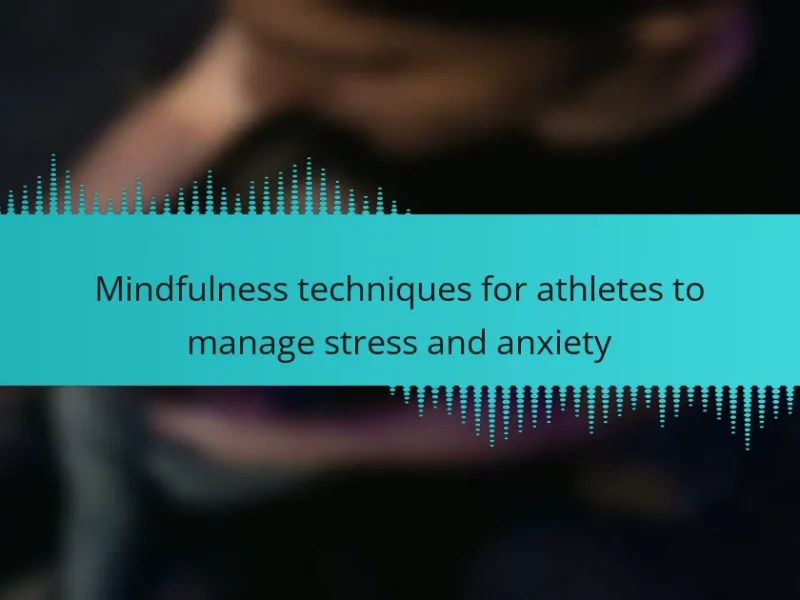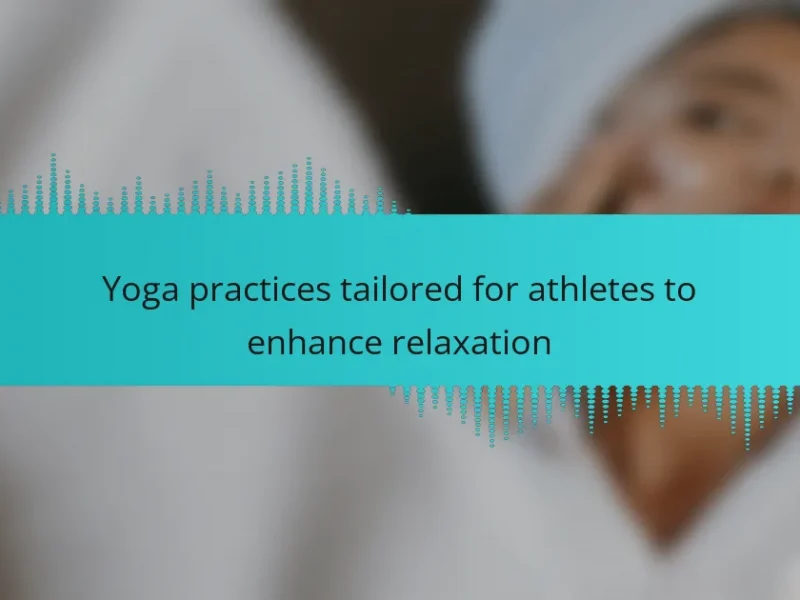Reducing athlete anxiety is crucial for optimal performance. Visualization strategies enhance focus, boost confidence, and promote relaxation. Techniques such as guided imagery and breathing exercises build mental resilience. Understanding cultural influences and avoiding common mistakes can further improve the effectiveness of these methods.
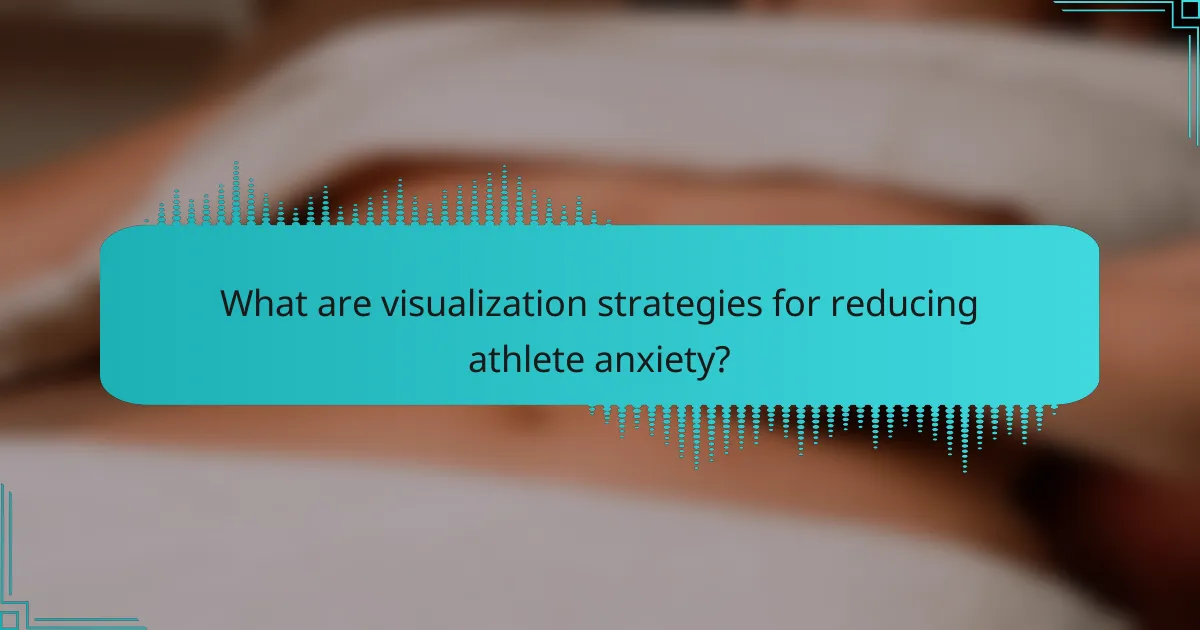
What are visualization strategies for reducing athlete anxiety?
Visualization strategies effectively reduce athlete anxiety by enhancing focus and promoting relaxation. Techniques include guided imagery, where athletes visualize successful performance, and breathing exercises that centre the mind. Practising these methods regularly builds mental resilience. Additionally, incorporating positive affirmations can reinforce confidence. These strategies collectively help athletes manage stress and improve performance outcomes.

What are the universal benefits of visualization techniques?
Visualization techniques significantly reduce athlete anxiety by enhancing focus, boosting confidence, and improving performance. These strategies help athletes mentally rehearse their actions, leading to better outcomes during competitions.
One universal benefit is the ability to create a calm mental state, which lowers stress levels. Visualization also fosters a positive mindset, enabling athletes to visualise success and overcome self-doubt. Research indicates that athletes utilising visualization techniques often experience improved concentration, allowing them to maintain peak performance under pressure.
Additionally, these techniques can enhance muscle memory by reinforcing motor skills through mental practice. As a result, athletes may find themselves better prepared for real-life scenarios, translating their visualised success into actual performance.
How does visualization impact performance under pressure?
Visualization significantly enhances performance under pressure by reducing anxiety. Athletes who employ visualization strategies can mentally rehearse their actions, leading to increased confidence and focus. Research indicates that visualising successful outcomes activates similar brain regions as actual performance, which can improve muscle memory and reaction times. Furthermore, athletes report feeling more relaxed and prepared, which mitigates the effects of pressure during competition. This mental practice can be particularly beneficial in high-stakes situations, allowing athletes to maintain composure and execute their skills effectively.
What psychological mechanisms are involved in visualization?
Visualization employs psychological mechanisms such as mental imagery and cognitive restructuring to alleviate athlete anxiety. Mental imagery allows athletes to create vivid images of success, enhancing confidence and focus. Cognitive restructuring helps reframe negative thoughts, promoting a positive mindset. These mechanisms work synergistically, enabling athletes to manage anxiety effectively and improve performance.
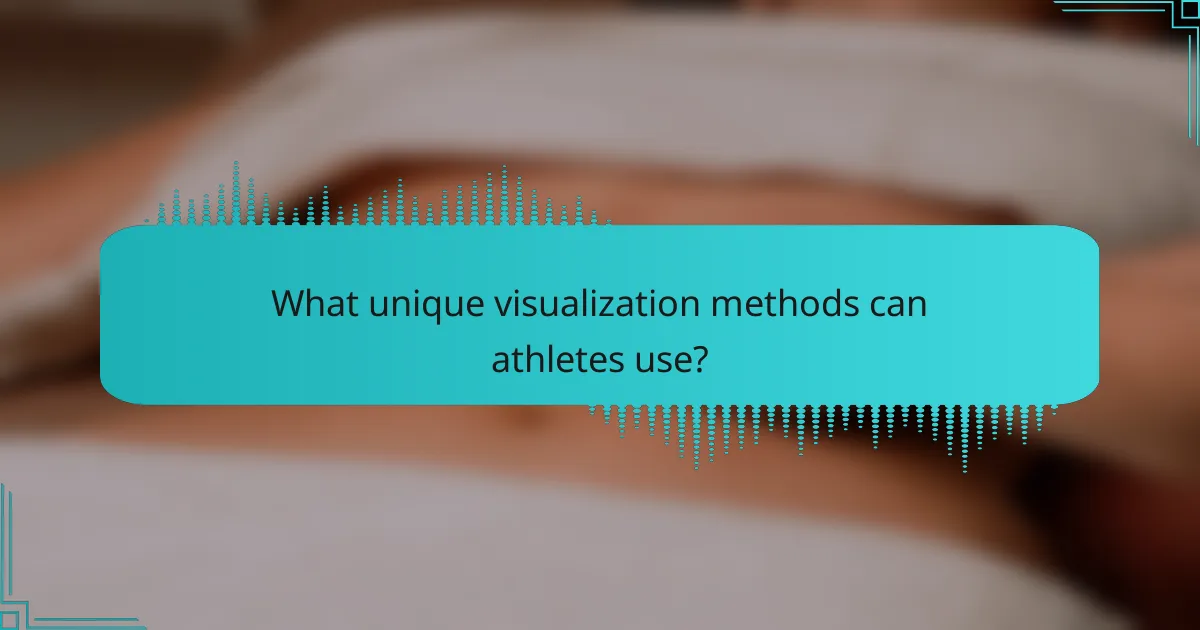
What unique visualization methods can athletes use?
Athletes can utilise unique visualization methods like mental imagery, guided visualization, and video analysis to reduce anxiety. Mental imagery involves vividly picturing successful performances, enhancing confidence. Guided visualization uses audio cues to lead athletes through relaxing scenarios, promoting focus. Video analysis allows athletes to review past performances, reinforcing positive outcomes and reducing anxiety through familiarity.
How can guided imagery enhance focus and calmness?
Guided imagery enhances focus and calmness by promoting mental clarity and relaxation. This technique allows athletes to visualise success, reducing anxiety and improving performance. It activates the brain’s relaxation response, lowering cortisol levels and fostering a sense of control. Practising guided imagery regularly can lead to improved concentration and emotional regulation during competition.
What role does mental rehearsal play in competition preparation?
Mental rehearsal significantly enhances competition preparation by reducing athlete anxiety. This technique allows athletes to visualise their performance, improving focus and confidence. Research indicates that mental imagery can lower stress levels and enhance emotional regulation, contributing to a more optimal performance state. By mentally practising scenarios, athletes can create familiarity with competition environments, which can mitigate anxiety and improve overall readiness.
What specific steps are involved in effective mental rehearsal?
Effective mental rehearsal involves several specific steps that enhance visualization strategies for reducing athlete anxiety. First, athletes should identify their performance goals and visualise the desired outcomes. Next, they should create a detailed mental image of their performance, incorporating sensory details such as sight, sound, and emotion. Following this, athletes should practise the visualization regularly, ideally in a calm and focused environment, to reinforce the mental pathways. Finally, they should integrate relaxation techniques, such as deep breathing, to manage anxiety and enhance focus during the rehearsal process.

What rare visualization techniques exist for elite athletes?
Elite athletes can utilise rare visualization techniques to effectively reduce anxiety. Techniques such as dynamic imagery, where athletes visualise movement in real-time, and multisensory visualization, which incorporates sounds and feelings, offer unique benefits. These methods enhance focus and create a deeper connection to performance, ultimately leading to improved mental resilience.
How can athletes use virtual reality for anxiety reduction?
Athletes can use virtual reality to reduce anxiety through immersive visualization strategies. By simulating competitive environments, athletes can practise mental rehearsals that enhance focus and confidence. This technique allows them to confront anxiety-inducing scenarios in a controlled setting, leading to improved performance. Research indicates that virtual reality exposure can significantly lower pre-competition anxiety levels, making it a valuable tool for mental preparation.
What are the emerging trends in visualization technology?
Visualization technology is increasingly focused on reducing athlete anxiety through immersive experiences. Techniques such as virtual reality (VR) and augmented reality (AR) create environments that simulate high-pressure situations. These tools help athletes practise coping strategies, enhancing their mental resilience. Data analytics also play a role, providing insights into performance patterns that contribute to anxiety. By leveraging these technologies, athletes can develop personalised visualization strategies to improve focus and reduce stress.
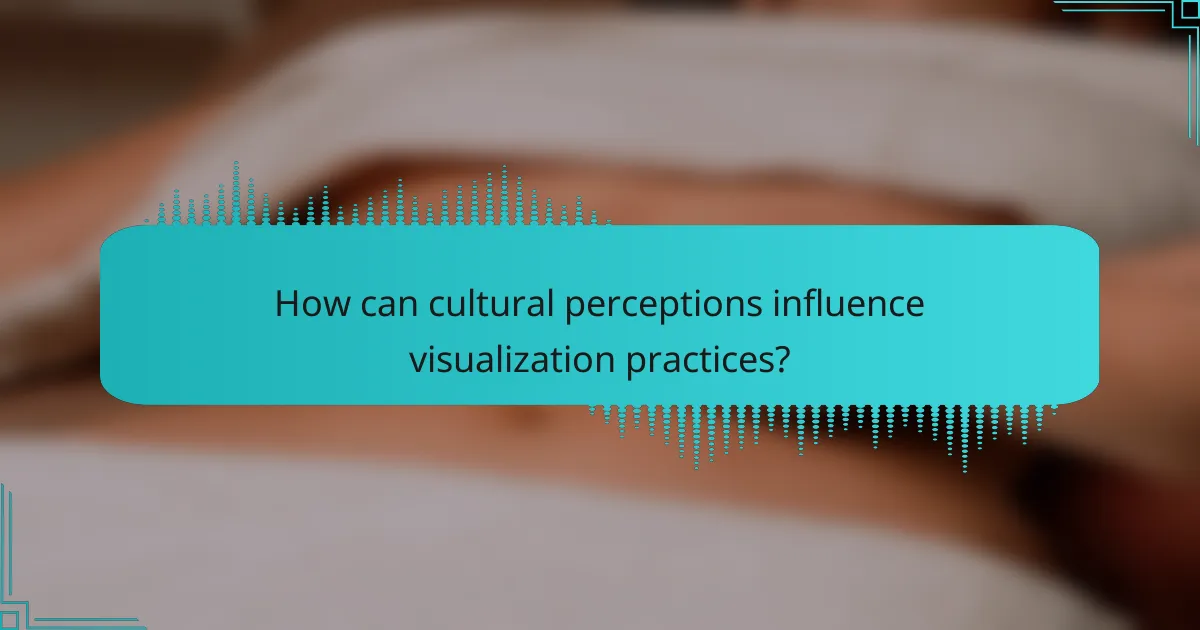
How can cultural perceptions influence visualization practices?
Cultural perceptions significantly shape visualization practices for reducing athlete anxiety. Different cultures may emphasise various mental techniques and imagery types, influencing athletes’ effectiveness. For instance, Western cultures often focus on individual achievement, leading to self-reinforcing visualization strategies. In contrast, collectivist cultures may prioritise team dynamics, promoting imagery that fosters group cohesion. These cultural nuances can dictate the preferred visualization methods, impacting athletes’ anxiety levels and overall performance. Understanding these cultural influences allows coaches to tailor strategies that resonate with individual athletes, enhancing their mental resilience.
What visualization approaches are popular in different sports?
Visualization strategies for reducing athlete anxiety vary across sports, utilising methods tailored to specific disciplines. Common approaches include mental imagery, where athletes visualise successful performances, and relaxation techniques that help manage stress.
In team sports like football, visualization often focuses on game strategies and teamwork dynamics. Athletes may envision plays and their roles within the team to enhance confidence and reduce anxiety. Individual sports like tennis emphasise personal performance, where players visualise their strokes and mental resilience.
Additionally, sports like gymnastics incorporate visualization for complex routines, helping athletes mentally rehearse movements to foster precision and calmness. In combat sports, visualization may centre on opponent analysis, enabling athletes to mentally prepare for various scenarios.
Ultimately, these visualization techniques not only reduce anxiety but also enhance overall performance by fostering a positive mental state.
How do regional attitudes towards mental training affect athletes?
Regional attitudes significantly influence the adoption of visualization strategies among athletes. Cultures that prioritise mental training often see athletes employing these techniques to effectively manage anxiety. For instance, athletes in regions with a strong emphasis on psychological resilience report lower anxiety levels during competitions. Conversely, areas with less focus on mental preparation may hinder athletes’ ability to utilise visualization, leading to higher anxiety. This disparity illustrates how cultural perceptions can shape athletes’ mental training approaches, ultimately affecting their performance outcomes.

What are the common mistakes athletes make with visualization?
Athletes often make mistakes with visualization that can hinder performance. Common errors include lack of specificity in mental imagery, failure to incorporate all senses, neglecting emotional aspects, and inconsistent practice. Focusing on these areas can enhance the effectiveness of visualization strategies for reducing anxiety.
How can athletes optimise their visualization practice?
Athletes can optimise their visualization practice by integrating specific techniques that reduce anxiety. Utilising guided imagery helps create a mental environment conducive to performance. Practising regularly enhances familiarity, making visualization more effective during competition.
Incorporating sensory details into visualisations, such as sounds and feelings, deepens the experience, further reducing anxiety. Setting clear goals for each visualization session can also enhance focus. Engaging in mindfulness during practice allows athletes to remain present, minimising negative thoughts.
Lastly, tracking progress through journaling can provide insights into what techniques yield the best results, fostering continuous improvement in visualization practices.
What expert insights can enhance the effectiveness of visualization?
Visualization techniques can significantly reduce athlete anxiety by enhancing focus and confidence. Expert insights suggest incorporating mental imagery, which allows athletes to visualise success and manage stress effectively.
Utilising structured visualization sessions before competitions helps athletes create a mental blueprint for performance. This method can include visualising specific movements, environments, and emotional states, which collectively contribute to improved mental preparedness.
Additionally, incorporating breathing exercises during visualization can further enhance relaxation. This approach aligns with the unique attribute of visualization, as it not only promotes mental clarity but also reduces physiological symptoms of anxiety.
Regular practice of these visualization strategies cultivates a rare attribute: resilience. Athletes who consistently engage in visualization develop an adaptive mindset, enabling them to cope better with competitive pressures.

